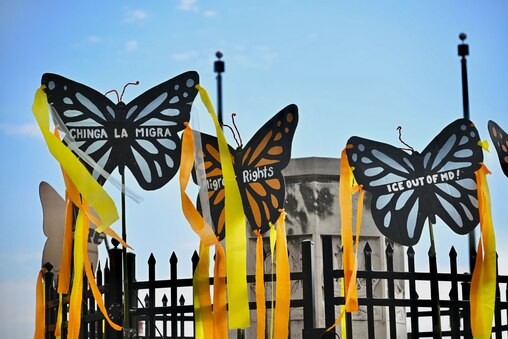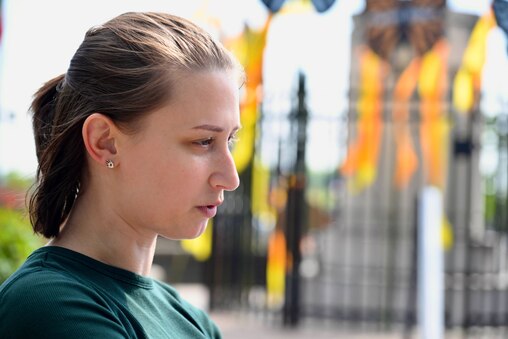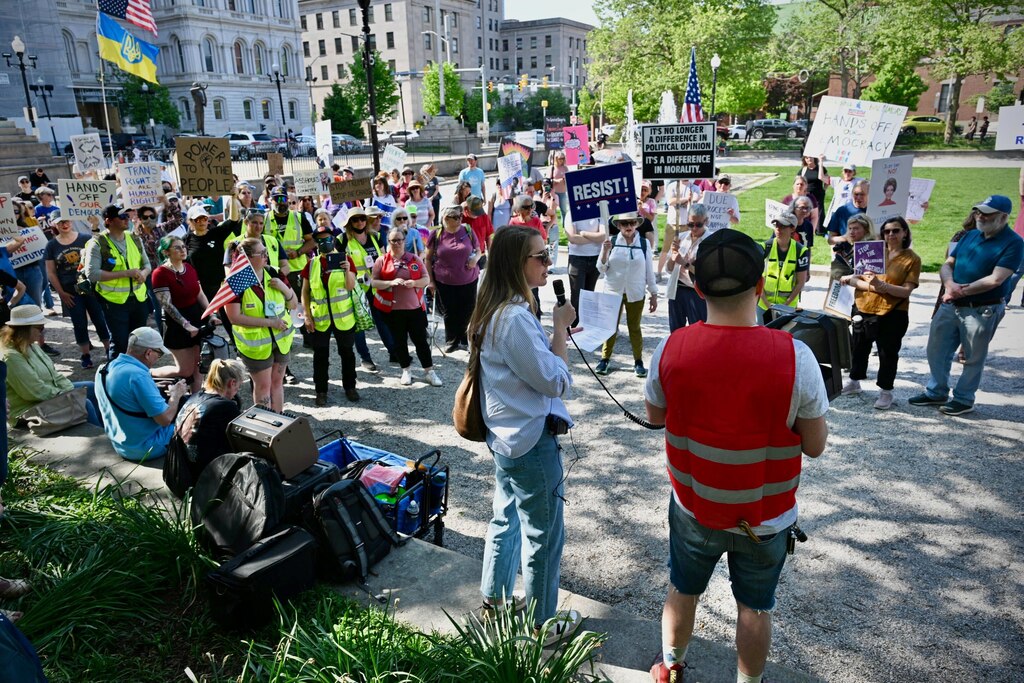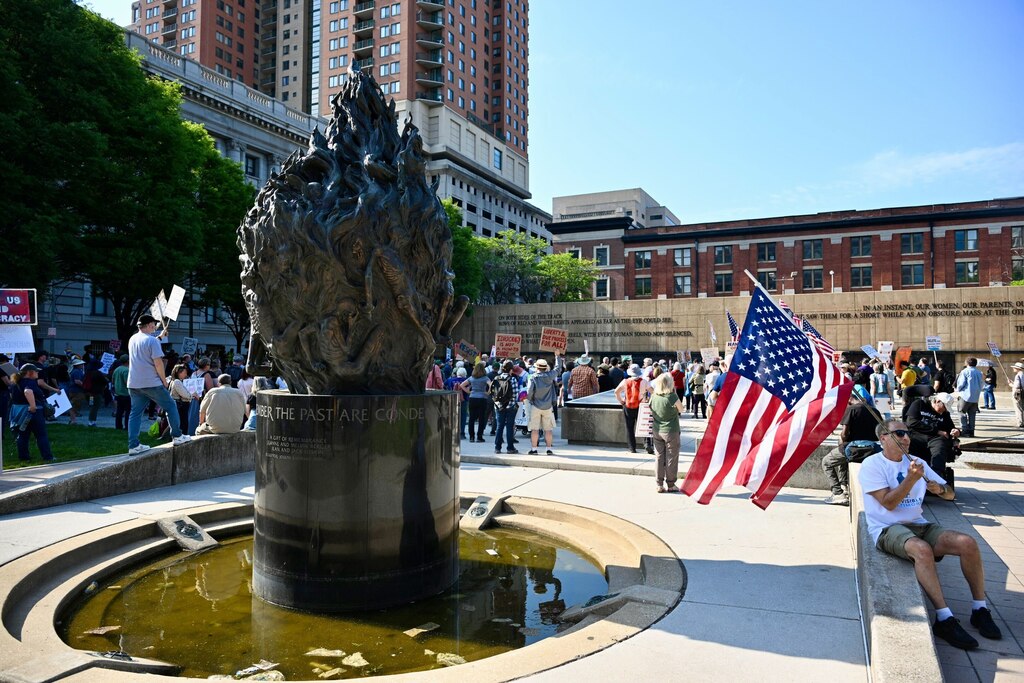Laid off in March, Hannah Pursley came to Columbus Park Thursday to deliver a message, surrounded by protesters hanging shimmering orange and blue butterflies and signs demanding the release of Kilmar Abrego Garcia, a Maryland man who was wrongfully deported.
A clinical social worker, Pursley had provided legal and social services to immigrants until her organization’s government contract ended.
“It was devastating. It felt like all the helpers were being punished,” she said, adding that tens of thousands of migrant children could go without legal support.
In Baltimore, the demonstration in support of immigrants was among several May Day marches that filled city streets with about 3,000 protesters who converged at the Inner Harbor’s McKeldin Square.
The Baltimore Banner thanks its sponsors. Become one.
The causes animating participants included student rights and universities facing funding cuts, the war in Gaza and the power of billionaires. But central to the 50-plus partnering organizations are efforts to combat actions by the Trump administration that they believe are harming their communities.
Every year, members of labor unions and others take to the streets to stand up for various causes on May Day. But this year the May 1 event landed with more urgency as upheaval by the Trump administration has sparked concerns about everything from mass firings at federal agencies to abrupt deportations that have drawn scrutiny from the courts.


Rallies from Washington to Los Angeles have not attracted the massive crowds seen during the first Trump administration, though they appear to be more numerous. They come amid heightened threats and consequence for protesters and those who opposed the Trump administration.
“The actions of the first 100 days of the Trump administration have touched everyone’s life in this country, and especially so in Baltimore,” says Anna Evans-Goldstein, a leading organizer. “And we want to speak very loudly to show people that we are the many and they are the few.”
President Donald Trump this week hailed his first 100 days as a triumph, despite polls that show him with the lowest popularity of any president at this juncture in 80 years.
The Baltimore Banner thanks its sponsors. Become one.
Polls have also shown many people are concerned about the role of billionaire Tesla CEO Elon Musk and his work with the Department of Government Efficiency in ordering cuts at federal agencies.
As protesters flooded St. Paul Street, shutting down traffic, Nicole Richardson stood on a stoop in awe.
“I’m just at work, and I had no idea this was going on,” Richardson said, holding her phone out to film the crowd. “It‘s really encouraging that people are taking a stand in this way.”
“This is just amazing,” Richardson added, shaking her head.
‘I’m here to support my students’
University of Maryland, Baltimore County, professor Andrea Kalfoglou arrived at Penn Station about 20 minutes before a rally in support of college students and faculty, who have faced visa revocations, federal investigations of student protesters and funding cuts.
The Baltimore Banner thanks its sponsors. Become one.
“I’m here to support my students who are struggling right now,” said Kalfoglou, who teaches public health. “I need to feel a sense of solidarity with other Maryland faculty at this moment.”
The University of Maryland Senate voted last week voted to join an alliance of Big Ten colleges that have agreed to protect one another against potential attacks from the Trump administration, which has sought to place more oversight over universities that is has accused of allowing antisemitism and discrimination.
Kalfoglou said she hoped the UMBC faculty would join the University of Maryland, College Park, university senate in supporting the alliance , even though her college isn’t in the Big Ten.
“I want to speak with other faculty about the defense contract,” she said. “It‘s too urgent to ignore.”
April Wuensch, a modern language and literature lecturer at Johns Hopkins University, said the protest was necessary because things “are really that bad right now.”
The Baltimore Banner thanks its sponsors. Become one.
Academia is under an unprecedented attack, Wuensch said.
May Day protesters march down St. Paul Street. (Ellie Wolfe/The Baltimore Banner)
The lecturer said she would like to hear more about what university leaders are doing to protect students and staff.
Hopkins graduate student Sheridan Ward told the crowd that the university wouldn’t “put people over profit” unless students, faculty and staff demanded it.
“We demand that Hopkins stand up for us,” said Ward, who is studying medieval history. “We will not rest until Hopkins releases a concrete plan of action.”
A spokesperson for Johns Hopkins said the university “deeply values our international students and staff, and we remain committed to maintaining healthcare, learning, and working environments that allow for the discussion and dialogue essential to academic and community life.”
The Baltimore Banner thanks its sponsors. Become one.
“We have regularly communicated with our community about the range of support services we provide for our international affiliates, as well as our longstanding policy of not providing information about a JHU affiliate’s immigration status unless required by law and not allowing immigration authorities access to private JHU facilities absent a court order,” the JHU spokesperson added.
One woman, rolling a suitcase behind her, emerged from Penn Station, shaking her head.
“Maybe if you went to better schools you’d understand,” she scoffed at a small group. “Losers.”

History of May Day
May 1 became International Workers Day in 1889 in honor of the efforts of labor organizers during the Haymarket Affair, a peaceful rally that turned violent as workers pushed for an eight-hour workday, according to the American Postal Workers Union.
At the labor rally outside Camden Yards just before 5:30 p.m., where the New Baltimore Christian Warriors marching band led the nearly 300 marchers down Pratt Street.
The Baltimore Banner thanks its sponsors. Become one.
Cheers greeted the group as it arrived at McKeldin Plaza, connecting organized labor with the rest of the protesters.
Ray Baker, Maryland director for the Baltimore-DC Metro Building Trades Council, told the gathered protesters that there was a new department in the United States.
“The Department of People Who Work for a Living!” Baker said to cheers from the crowd.
Baker also made an explicit call for the return to the U.S. of “our union brother” Abrego Garcia.
‘Nobody voted for this’
Nearly 200 people crowded outside City Hall for a pro-democracy 99 vs. 1 march.
Several cars and buses passing through downtown honked their horns at the protesters who sported American flags and signs calling for protection of their rights and “Power to the People.”
“Whose streets? Our streets!” they changed as they walked through the streets.
“Show me what community looks like! This is what community looks like!”
“Feed the people! Tax the rich!”
Dorrie Bright-Whitson, and her husband, Dan Whitson, have participated in three other protests since the start of the second Trump administration. They said they have been writing and calling their elected officials to oppose what they believe are illegal actions by Trump that have gone unchecked by Congress.
“It‘s happening so fast, but there’s not enough people slowing it down,” Dan Whitson said.

The 99 vs. 1 march was organized by several groups including, Allies for Democracy.
“Many people voted for Trump because they were worried about inflation and the price of eggs,” a spokesperson for Allies for Democracy said in a statement. “Nobody voted for this.”
War in Gaza
A march to protest the war in Gaza and resist attempts to curtail free speech was a joint effort by several groups including: About Face: Veterans Against the War.
“As veterans, we’re disgusted that elected officials are using our military and our tax dollars to fuel obvious war crimes in Gaza while they simultaneously cut our lifesaving VA benefits and Medicaid,” said Ariel McIntosh, a Navy vet and member of the veterans’ anti-war group.
The war began on Oct. 7, 2023, when Hamas launched a surprise attack in southern Israel, killing some 1,200 people, mostly civilians, and taking around 250 people hostage. Israel responded with retaliatory airstrikes and an incursion into Gaza, and the territory’s health ministry says more than 52,000 Palestinians have been killed.
He added, “On this International Workers Day, we call on workers and military members to stand up in solidarity with Palestinians.”

The Associated Press contributed to this story.




Comments
Welcome to The Banner's subscriber-only commenting community. Please review our community guidelines.